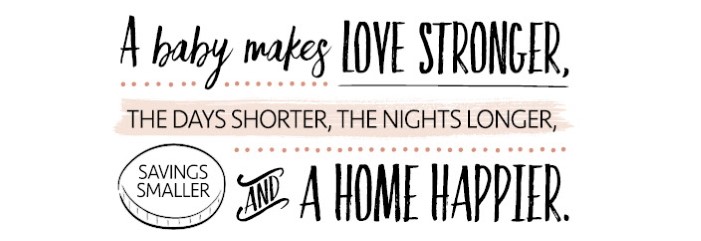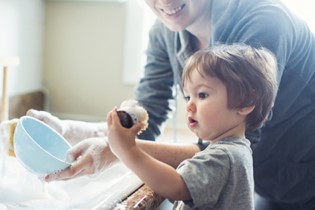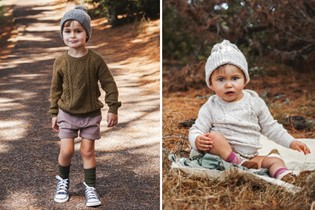Newborns and the fourth trimester

Congratulations on your new arrival – and welcome to the fourth trimester! Dorothy Waide shares her tips on adjusting to life with your precious newborn.
The fourth trimester (the first 3 months after baby is born) is an exciting but exhausting time for parents. It’s all about getting to know your little one, figuring out your role and learning how to navigate life with a baby – merging your old lifestyle with your new reality, all through a fog of sleep deprivation. It’s no wonder you feel like you need a map! Or at least a few words of encouragement from others who have already journeyed this path.
My first advice to people is to take time out from everyday routines and hibernate, where possible, cocooning yourselves so you can focus on getting to know your baby. This is tricky for parents with older children, in which case I strongly encourage you to call on extended family or friends to step in and support you, allowing you time to adjust to your new family dynamic.
NOW TO NURTURE
There is so much information for new parents to take in but, put simply, the fourth trimester is all about nurturing. Babies thrive on being held close so they can sense the rhythm of your heartbeat, your familiar smell and the warmth of your body. This intimacy emulates the womb and helps build a sense of trust, confirming to your baby that life outside the womb is safe. In a sense, parents are like shock absorbers; holding your baby close absorbs their anxiety and tension so they’re able to relax and feel secure.

Feeding, burping, changing nappies and helping your baby find their sleep are all part of nurturing and getting in tune with Baby. However, nurturing is not just about ‘doing’. Sometimes nurturing is simply about ‘being’. It can be as passive as watching your baby while she sleeps, holding her quietly in your arms or taking an afternoon nap together.
Many parents embark on this journey feeling anxious and scared of failing. For others, getting to know their baby may be the most intimate relationship they’ve experienced, and as daunting and overwhelming as it is, it’s equally fulfilling and rewarding. It’s important not to compare yourself to others – you really are the best parent for your child and you’re doing a great job, even if you do feel overwhelmed.
Everyone’s experience of the fourth trimester, and all the feelings that accompany it, is different. As time passes and expectations are put to rest, parents often discover an internal strength. I always encourage parents to trust themselves and follow their gut – I firmly believe this is key to finding your feet as a new parent.

SOMETHING TO SAY
Remember, crying is natural. Initially it’s your baby’s only form of communication. When we think of it like that, it’s easier to respond positively to their crying. When someone is communicating with us, we stop, listen and act. ‘Act’ relates to what you are going to do for your baby when they’re calling you, which is often easier said than done, right? Figuring out what to do when a baby is crying can be the most stressful and confusing element of parenting, especially in the fourth trimester.
However you choose to parent, looking after little ones takes TACT – time, acceptance, consistency and touch. You cannot spoil a newborn, and I gently remind parents of this whenever I can. You’re not going to make a rod for your back by holding your baby in your arms. Remember, this season is all about nurture. It’s okay if your baby sleeps in your arms during the day, but I do encourage parents to aim for getting their baby to sleep in her bassinet or cot as much as possible at night.
MOVING TO A COT
Transitioning your baby to settling and sleeping in a cot is where things can get tricky. For the first 12 weeks you’re advised to rock, walk, swing or drive baby to sleep, even put her in a buggy and ‘bump’ her over a cord on the floor, but at around 16 weeks the same people then advise you to put her into her cot with no movement and expect her to sleep. It’s difficult for a baby who has learnt to settle with movement to suddenly re-learn settling while in complete stillness. My advice is to always sit still when baby is sleeping in your arms, with no large movements. Your body thus becomes the mattress and, if need be, you can do a small movement on your baby’s body that can later be replicated in a cot. I call this movement cupping and you can find tutorial videos explaining this further on my website.
SETTLING BASICS
When baby is all swaddled and ready for sleep, I suggest you place her in her cot ready to find her sleep and then choose one of three options:
- Stay in the room next to the cot, your hand resting on baby.
- Stay in the room without touching baby, but lie down and do some relaxation breathing.
- Leave the room.
Your baby will likely grizzle and make noises and this is where you again have choices. I advise stepping in quickly with a newborn, either reassuring her with touch or picking her up in an engulf hold. Your baby will likely continue to cry on and off. You can intervene with cupping and shushing and repeat these steps until she goes to sleep. Babies are not designed to fall asleep ‘just like that’ – they need your support to help them find their sleep. Swaddling is a hotly debated topic these days, due to the ways a swaddle can potentially restrict natural reflexes. Reflexes are what a baby uses to reset their heart rate, their breathing and their temperature. In my experience, some babies really need to be swaddled in order to settle, as the cocoon-like feeling of a swaddle reminds them of the womb. I think the conversation should focus more on healthy swaddling techniques, rather than saying a blanket (excuse the pun!) ‘No’ to swaddling. For example, swaddling baby with her arms across her body or her hands up will minimise a strong startle reflex that could wake her, but will still allow enough healthy movement. As with any parenting topic, do your research so you can make an informed decision that best meets the needs of your family.
Many parents find white noise helps soothe their baby, as it’s believed to replicate sounds they heard in the womb. My concern is that continuously played white noise may encourage light sleeping. It’s also important that your baby learns to sleep through household noises. If you’re using white noise because of loud outside noises, place the machine close to the window to drown the noises out. And for early morning noises, such as birds singing, try putting the white noise machine on a timer.
It’s recommended that white noise be played between 50 and 75 decibels. A study conducted by a Canadian research group found that white noise devices can produce sounds loud enough to cause hearing loss after prolonged exposure, and they suggest the following guidelines for safer use:
- Place your white noise device as far away as possible from your baby and never in the cot or on the rail.
- Play the device at a low volume.
- Operate the white noise for a short duration of time. My hesitation with using white noise and other sleep aids (movement, dummies etc) is that they prevent your baby from self-settling and resettling on their own. I suggest you first allow your baby a chance to find sleep on their own, and then introduce a sleep aid if need be.
TRUST YOUR GUT
Parenting is personal. If you’re concerned about something, seek advice and information, then trust your gut instincts. There’s a lot to think about during the fourth trimester but the most important thing to remember is that this season is about laying foundations for babies to experience nurturing love and security. Parenting a newborn is a steep learning curve, but it’s a rich and rewarding one. Be kind to yourself, sit back and enjoy the cuddles.
|
SAFE SLEEP, EVERY SLEEP
SAFER CO-SLEEPING PRACTICE INCLUDES: ◼️ Ensuring bedding is tight, ideally fitting to the mattress. ◼️ Ensuring your mattress is firm. ◼️ Using a sheet or lightweight blanket to cover only the lower part of your body. ◼️ Wearing layers of clothing to keep your upper torso warm (instead of blankets). ◼️ Using an infant wahakura or pepi pod in accordance with the manufacturer’s instructions. ◼️ Placing your baby beside one parent, not between parents. ◼️ Placing your baby where they cannot fall out of the bed, but not against pillows or a wall.
THINGS NOT TO DO IF BED SHARING: ◼️ Sleeping with your baby is not advised if you or your partner are under the influence of recreational drugs or alcohol, or while you are smoking. ◼️ Do not use a waterbed. ◼️ Do not sleep on a sofa where your baby could easily roll into the cushions or roll off onto the floor. ◼️ Do not cover your baby with any sheets, duvets or other bedding. ◼️ Do not use pillows to surround your baby. ◼️ Avoid mohair and any fabric with loose fibres and threads. ◼️ Do not place baby on the wall side of the bed, as they may become trapped. |
Dorothy started her career as a Karitane Mothercraft nurse in the 1970s and is now one of NZ’s leading baby and toddler sleep experts. Following the success of You Simply Can’t Spoil a Newborn, Dorothy’s second book, Simply Parenting – From 12 Weeks to 12 Months, will be available in August,2020. Find Dorothy at facebook.com/BabyWithin and babyhelp.co.nz.

AS FEATURED IN ISSUE 49 OF OHbaby! MAGAZINE. CHECK OUT OTHER ARTICLES IN THIS ISSUE BELOW

















